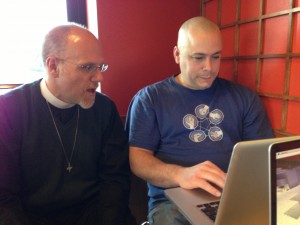
Although most of their collaboration is via the internet or telephone, Pastor Galler at length describes his high expectations of the Pilgrim website to programmer Mark Young when the two met in person at a Dallas Starbucks on January 3, 2013.
While any glory or praise for this website properly goes to God, on this page we both give some earthly credit where such earthly credit is due and explain the two images on the top of this and every page of the site: the Luther Rose and the LCMS Cross.
Pastor Galler is the primary author of most of the content on our website, and our primary programmer is his friend and brother-in-Christ from Austin, Mark Young. Pastor Galler had previously contributed content to the websites of both Grace Lutheran Church, Elgin, Texas, as that congregation’s assistant pastor, and of St. Paul Lutheran Church, Austin, Texas, as a member of that congregation. So, some of the content of Pilgrim’s website is drawn from those websites, and others’ work contributing to and revising that content is hereby acknowledged. Pastor Galler and Mark Young worked together on the St. Paul site, and Mark Young has continued to work with Pastor Galler on the Pilgrim site. Mark has facilitated this site’s use and adaptation of the content-management software WordPress, and especially the Sermons application tailored to the St. Paul and Pilgrim sites is a proprietary product of Mark’s programming. The general Pilgrim website itself is hosted by Just Host. Our member Remo Gualtieri assists with editing, uploading, and posting audio, video, and other files. Currently, graphic elements for Pilgrim’s site are being done with the help of our member Katy Myers, while other graphic elements in the past have had assistance from Carla Adsit, Seth and Samantha Hiltzman, Carol Norman, and the Rev. Christopher K. Nuttelman. Still other graphic elements, such as the following, have a longer history. (We try to acknowledge the sources of all graphic elements that are not in the public domain; if we have unintentionally infringed your copyright, please let us know, and we will either give you credit or cease using the item.)
Luther Rose
A cross on a heart, resting on the center of the Messianic Rose and surrounded by a circle to symbolize eternity, was adopted by Luther as his own Coat of Arms and as an expression of trust in God. He explained what is known as the Luther Rose in the following way:
First there is a black cross set in a heart of natural color to remind me that faith in the Crucified One saves us . . . This heart is mounted in the center of a white rose to show that faith brings joy, comfort and peace . . . The rose is set in a sky colored field to show that such joy of the spirit and faith is the beginning of the heavenly joy to come, present already in our joy now and embraced by hope, but not yet made manifest.
An English verse usually associated with Luther’s Rose is as follows:
The Christian’s heart is resting on roses
E’en while beneath the cross it reposes.
While the Luther Rose for some may be an unfamiliar symbol, it transcends provincial logos and communicates a traditional Lutheranism to those who recognize it. Note that while the slogans “Word alone, Faith alone, Grace alone” are included here, they are not an original part of the Luther Rose nor were they slogans per se of the Reformation. However, insofar as the Word testified is of Christ, Faith is in Christ, and Grace is on account of Christ, the slogans are in keeping with the Luther Rose’s and Luther’s own emphasis on Christ alone.
LCMS Cross
The Lutheran Church—Missouri Synod (LCMS) cross is three crosses in one, as the Holy Trinity is three Persons in one God. The Synod, with the Christian Church of all times and places, worships and so confesses “one God in Trinity and Trinity in Unity.” The open arms of the cross point upward, as if to God in prayer and to openly receive God’s grace coming down. The lower arms point down, as if open to embrace the world with God’s love. All four arms appear to be in motion, as we in word and deed tell the world about God’s love for it in Jesus Christ. (The twelve individual parts of the cross can be associated with the twelve tribes of Israel or the twelve apostles.)
Originally and for nearly 30 years in three shades of burgundy (though no specific symbolism was apparently ever attached to the burgundy shading), the LCMS cross in 2012 was officially “updated” to three shades of royal blue, in connection with the Synod’s restructuring of offices and departments and unification of activities. The re-coloring of the existing logo was said to show that, amid the many changes, the essence of the Synod had not changed. The royal blue was seen as a classic, conservative color that would stand the test of time and set a friendly and inviting tone. The use of the burgundy version, however, was still permitted as long as anyone wished to use it, and the burgundy version is better recognized as the distinctive cross of the LCMS, especially given the similar blue cross used by Lutheran Church Canada, which synod was originally districts of the LCMS and whose blue cross was itself based on the original LCMS cross.

